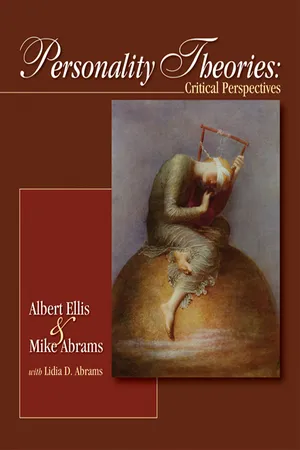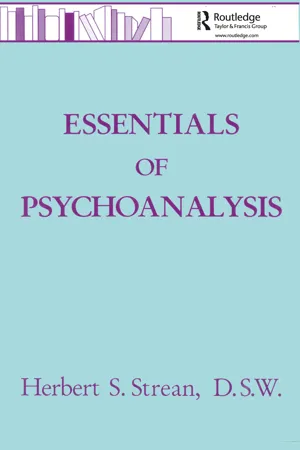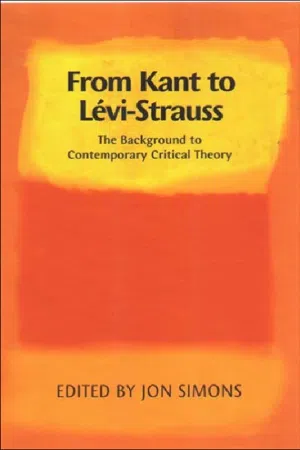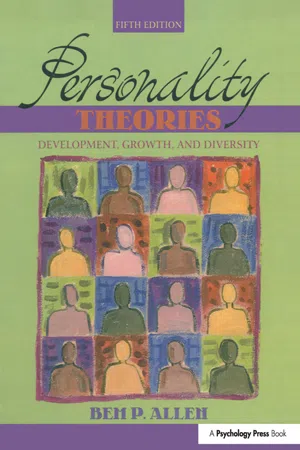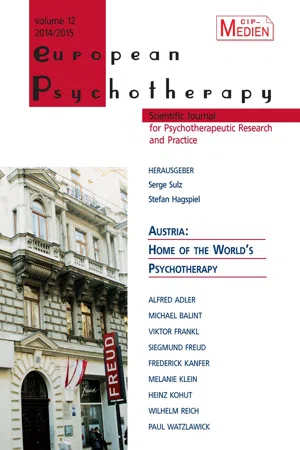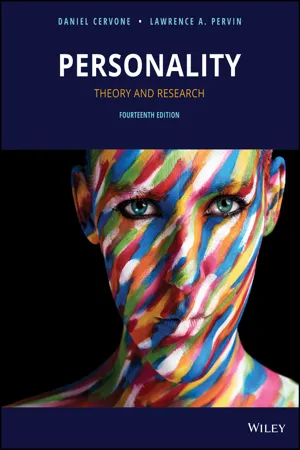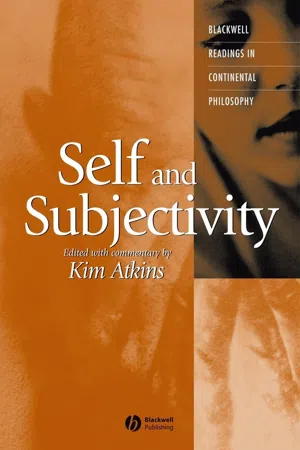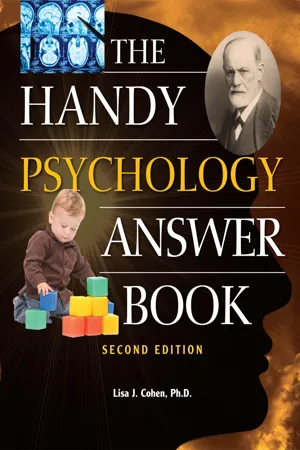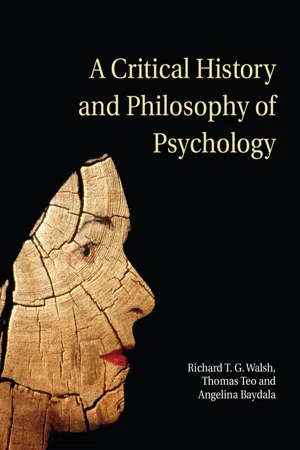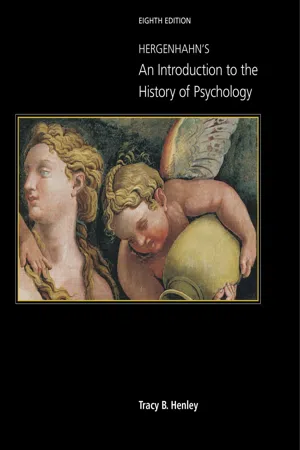Psychology
Sigmund Freud
Sigmund Freud was an Austrian neurologist and the founder of psychoanalysis, a clinical method for treating psychopathology through dialogue between a patient and a psychoanalyst. He is best known for his theories on the unconscious mind, the role of childhood experiences in shaping adult personality, and the development of psychosexual stages. Freud's work has had a profound influence on psychology and continues to be widely studied and debated.
Written by Perlego with AI-assistance
Related key terms
1 of 5
12 Key excerpts on "Sigmund Freud"
- eBook - ePub
Personality Theories
Critical Perspectives
- Albert Ellis, Mike Abrams, Lidia Abrams(Authors)
- 2008(Publication Date)
- SAGE Publications, Inc(Publisher)
Chapter 4Freud and the Dynamic Unconscious
Chapter Goals- Place psychoanalysis in its historical context
- Discuss Freud the man and the time in which he wrote
- Explain the development of psychoanalytic theory
- Detail the components and complexities of Freud’s theories
- Understand the pervasive influence of Freud and his theories
- List and explain some alternative points of view and the controversies surrounding Freudian theory
PSYCHOANALYSIS: THE FIRST COMPREHENSIVE THEORY OF THE PSYCHE
Chapter 2 put forward various historical views of personality and showed how these views have evolved over the last two millennia. There were a few critical points over the course of this history; one of them was Sigmund Freud’s development of psychoanalytic theory. Freud is a pivotal figure not because he discovered previously unknown essential truths about human nature but rather because he set a standard for personality psychology. Freud proposed a comprehensive explanation of virtually all aspects of human behavior, both individual and collective. In addition, he attempted to explain how behavior developed in the individual and how the individual develops as a member of the human species (Ellenberger, 1970).Photo 4.1 Sigmund Freud (1856–1939)There are grave problems with many facets of Freud’s theory. Even in Freud’s inaccuracies, however, there is an intellectual elegance and intrigue that is at least in part responsible for the popularity of his ideas. Like them or not, Freud’s theories have profoundly influenced many aspects of 20th- and 21st-century Western culture, from the graphic arts and literature to film and drama, as well as the practice of psychiatry. It is quite likely that you had heard of Freud before you opened this book or even before you took your first course in psychology. Terms like neurotic, anal, penis envy, Oedipus complex, or repression, were part of your vocabulary before you embarked on any study of psychoanalysis. And for better or worse, mental health professionals are inextricably linked with Freudian concepts in the minds of a large percentage of the lay public. The notion that psychoanalysis is synonymous withpsychotherapy - eBook - ePub
- Herbert S. Strean(Author)
- 2013(Publication Date)
- Routledge(Publisher)
1
FREUD AND HIS THEORY OF PERSONALITY
Just as psychoanalysis as a personality theory, treatment method, and research perspective has been steeped in controversy ever since its inception, Sigmund Freud, the founder of the art and science, may be regarded as one of the most controversial figures of the 20th century. Highly esteemed for his monumental discoveries, he is severely derogated for his alleged prejudices. Some aver that he is more influential than any other human being in civilization in acquainting us with the child in ourselves, while others blame him as a prime source of modern sexual libertinism and for many of the other ills of contemporary life (Roazen, 1975).Those who regard Freud as a genius compare him to Darwin, Einstein, or Galileo (Jones, 1957). They point to his many creative contributions such as the dynamics of the unconscious, infantile sexuality and psychosexual development, the interpretation of dreams, the role of fantasies, the process of free association, the crucial importance of transference in and out of the therapeutic situation, the inevitability of human resistance to change, and many more discoveries (Freeman & Strean, 1987).Those who condemn Freud view him as a male chauvinist who was a preserver of the status quo. They contend that he exaggerated the importance of the penis, erroneously postulated a death instinct, naively assumed that children inherit acquired characteristics, and incorrectly averred that women have weaker superegos than men (Masson, 1984, 1990).Even among psychoanalysts and other mental health professionals there is only limited consensus on Freud's findings. During the last two decades classical Freudians have been severely criticized by object-relations experts and proponents of self psychology, to name just two dissenting groups of psychoanalysts who fault Freud for many of his positions on personality formation and treatment. Yet, there are other clinicians who claim nothing much has been discovered about personality theory or treatment since Freud entered on the psychotherapeutic stage (Malcolm, 1981). - eBook - PDF
From Kant to Lévi-Strauss
The Background to Contemporary Critical Theory
- Jon Simons(Author)
- 2002(Publication Date)
- Edinburgh University Press(Publisher)
7 Sigmund Freud (1856–1939) Richard H. King Freud in the Critical Tradition At the centre of Freud’s remarkable achievement is that he tried, and largely succeeded in, expanding the meaning and range of the concept of mind or psyche as such. In that sense, he saw himself as challenging the conventional philosophical wisdom that all thinking that counts is conscious and that the mind is to be understood as the seat of rationality. Freud had no deep grounding in philosophy but was educated generally in classical and German literature and culture (which also entailed considerable knowledge of Shakespeare) and trained specifically in the biological sciences. Yet, though the form of Freud’s work is intended to be scientific, he is often regarded as an enemy of Enlightened rationalism, not only by those who question his scientific credentials but also by those who focus on the content of his work on the unconscious motivations of human behaviour. Freud has been grouped with Marx and Nietzsche as part of the core of the modernist tradition of the ‘hermeneutics of suspicion’. According to this general stance, what is obvious on the surface is less fundamental than what lies hidden underneath, which in Freud’s case is the work of the drives and of the unconscious parts of the psyche. With Freud this also implied that early childhood experience, mostly forgotten, was basic in shaping and explaining our adult selves. Thus we do not always, or even often, know the ‘real’ or original motivation for our thoughts, feelings or actions. This in turn put Freud at odds with the phenomenological-existentialist tradition of Husserl, Heidegger and Sartre. Although this tradition shared with Freud and psychoanalysis a focus on subjective experience, they rejected the idea of the unconscious or the assumption that we are determined by biological and/or early childhood experiences. In their view, such 97 - eBook - ePub
Personality Theories
Development, Growth, and Diversity
- Bem P. Allen(Author)
- 2015(Publication Date)
- Psychology Press(Publisher)
2The Psychoanalytic Legacy: Sigmund Freud
Sigmund Freud National Library of Medicine• Is the relationship between boy and mother special?• How much of what we call our “minds” is unconscious?• Is the unconscious revealed in our dreams?W hen asked about personality, Sigmund Freud responded in a tone usually reserved for the revelation of timeless truths. Some of his answers are important contributions to understanding personality. Others, offered with equal certainty, are less helpful. However, Freud clung to all of his ideas with great tenacity. He was suspicious of those who disagreed with any of his notions. Carl Jung, and many other early followers, soon split with Freud as their ideas began to deviate from his. Nevertheless, all were influenced by him, whether they admitted it or not.Freud, the Person
Sigmund Freud was born on May 6, 1856, in Moravia, a Germanic area that is now a part of the new Czech Republic. He was the oldest of Amalie and Jakob Freud’s eight children. Amalie, Jakob’s second wife, 20 years his junior, bore her “golden Sigi” at age 21. She had a lively personality and was sharp-witted. Jakob, a wool merchant, had a good sense of humor and was a liberal thinker. They were Jewish.Sigmund was scarcely 10 when he entered high school and only 17 when he entered medical school at the University of Vienna, where he used his photographic memory to excel as a student of neurology (1994 materials from the Freud Museum, Vienna). Young Freud was most influenced by Professor Ernst Brucke, a respected and disciplined physiologist with an uncompromising spirit and a stare that could petrify students.During medical school, Freud was preoccupied with becoming well known and economically secure by making some important discoveries (Jones, 1953; Parisi, 1987). His research as a student included: (1) dissecting 400 male eels to show, for the first time, that they had testes; (2) discovering new characteristics of neurons (nerve cells) in fish; and (3) developing the first gold-chloride technique of staining nerve tissue. It is also note-worthy that Freud’s notion of “contact barriers” anticipated the concept “synapse,” the space between neurons (Parisi, 1987). Using himself as a subject, he discovered that cocaine was an effective anesthetic (Parisi, 1987). However, contrary to still-circulating rumors, he was not a lifelong cocaine user. Nevertheless, he did once recommend the widespread use of cocaine, even by injection (McCullough, 2001). He was 25 when he received his MD degree (1994 materials from the Freud Museum, Vienna). - eBook - ePub
European Psychotherapy 2014/2015
Austria: Home of the World's Psychotherapy
- Serge Sulz, Stefan Hagspiel, Serge Sulz, Stefan Hagspiel(Authors)
- 2015(Publication Date)
- Books on Demand(Publisher)
Axel HolickiSigmund Freud and the importance of the unconscious
Comments on the life and work of an ingenious thinker (06.05.1856 – 23.09.1939)ABSTRACTThe author dispenses both with the repetition of familiar biographical details as well as with any comprehensive description of the theoretical structure of psychoanalysis. On the basis of biographical facts, the author discusses hypotheses on the personality development of Sigmund Freud which allowed him to create the extraordinary cultural edifice that is "psychoanalysis". The author equates acknowledgment of his own limitations and finiteness, a precondition for the capacity for psychoanalytic thinking, with the acceptance of the "unconscious", and describes the "unconscious" as the central pillar on which Sigmund Freud's theory of psychoanalysis is built. Proceeding from Freud's work "The Interpretation of Dreams" (1900a), from the theory of transformations, the author discusses examples of more recent developments which he attributes to the further development of the psychoanalysis of Sigmund Freud.All things the gods bestow, the infinite ones,On their darlings completely;All the joys, the infinite ones,All the pains, the infinite ones, completely.(Johann Wolfgang von Goethe, 1777)According to Wikipedia, the free internet encyclopaedia, Sigmund Freud "became known as the founding father of psychoanalysis. " Much has been written about Sigmund Freud, and a lot more about his life's work, psychoanalysis. A journal article about Sigmund Freud must necessarily remain incomplete. "What is required is no longer the broad sweep and the conclusive overall view which an individual could provide, but, rather, patient work on a mosaic made up of the diverse studies of researchers and researcher groups from various disciplines." (Kimmerle & Nitzschke, 1988, p. 6) The following comments are a selection from the very extensive scientific research on Freud's biography and on psychoanalysis. The selection focuses on the significance and the effect of the "unconscious". For anyone who is encouraged by this short journal contribution to read more, I recommend "Sigmund Freud. Living and Dying" by Max Schur (1972) . - eBook - PDF
Personality
Theory and Research
- Daniel Cervone, Lawrence A. Pervin(Authors)
- 2018(Publication Date)
- Wiley(Publisher)
A PSYCHODYNAMIC THEORY: FREUD’S PSYCHOANALYTIC THEORY OF PERSONALITY 54 Questions to be Addressed in this Chapter 1. How did Freud develop his theory, and how did historical and personal events shape this development? 2. What are the key features of Freud’s theoretical model of the human mind? 3. How do people protect themselves against experiences of anxiety, and in what ways (accord- ing to Freud) are these anxiety-reduction strategies a centerpiece of personality dynamics? 4. How important is early childhood experience for later personality development? Sigmund Freud (1856–1939): A View of the Theorist Sigmund Freud was born in Moravia (in what is now the city of Fribor of the Czech Republic) in 1856. His family soon moved to Vienna, where he spent most of his life. Freud was the first child of his parents, but his father, 20 years older than his mother, had two sons by a previous marriage. His parents then had seven more children after his birth. Within this large group of family mem- bers, the intellectually precocious Sigmund was his mother’s favorite—and he knew it. Later in life, Freud famously commented, from experience, that a man who has been the indisputable favorite of his mother “keeps for life the feeling of a conqueror, that confidence of success that often induces real success” (Freud, 1900, p. 26). As a boy, Freud had big dreams. He wanted to become a great general or government official. But anti-Semitism limited the possibility for advancement in these fields for Freud, who was Jewish. He thus pursued a career in medicine instead. ullstein bild / Contributor / Getty Images Sigmund Freud and his daughter Anna Freud. Both contributed to the development of psychodynamic conceptions of personality. Sigmund Freud (1856–1939): A View of the Theorist 55 Freud’s medical training, at the University of Vienna, profoundly shaped his later theorizing about personality. - No longer available |Learn more
- Duane P. Schultz; Sydney Ellen Schultz, Duane Schultz, Sydney Schultz(Authors)
- 2020(Publication Date)
- Cengage Learning EMEA(Publisher)
Ambiguous definitions of certain Freudian concepts have also been questioned. Critics point to confusion and contradiction in such terms as id, ego, and superego. Are they distinct physical structures in the brain? Are they fluid processes? In his later writings Freud addressed the difficulties of defining some of his concepts precisely, but the ques-tions remain. Freud ’ s Lasting Influence This book is a history of modern insights into personality. In our personal and social growth we are never free of our past, nor should we want to be. The past offers the foun-dation on which to build, as later personality theorists have built on Freud ’ s work. If psychoanalysis has served no other purpose than to inspire others and provide a frame-work within which to develop new insights, then Freud ’ s importance to the world of ideas is secure. Every structure depends on the soundness and integrity of its foundation. Sigmund Freud gave personality theorists a highly original, stimulating, and challenging base on which to build. Chapter Summary Freud ’ s theory is at least partly autobiographical in that he based some of his major concepts on his childhood experiences, dreams, and sexual conflicts. Instincts are mental representations of stimuli that originate within the body. Life instincts serve the pur-pose of survival and are manifested in a form of psychic energy called libido. Death instincts are an unconscious drive toward decay, destruction, and aggression. The three structures of the personality are the id, ego, and superego. The id, the biological component of per-sonality, is the storehouse of instincts and libido. It oper-ates in accordance with the pleasure principle. The ego, the rational component of personality, operates in accor-dance with the reality principle. The superego, the moral side of personality, consists of the conscience (behaviors for which the child is punished) and the ego-ideal (beha-viors for which the child is praised). - eBook - PDF
- Kim Atkins(Author)
- 2008(Publication Date)
- Wiley-Blackwell(Publisher)
15 COMMENTARY ON FREUD Sigmund Freud was born in Freiberg, Moravia, in 1856. He based his work and studies in Vienna until he fled the Nazi regime for England in 1938. He died in London in 1939. Freud’s work represents an unusual confluence of Romantic and scientific thought, combining the idea of powerful and arational forces with a rigorous science. Freud’s is a naturalistic materialist theory of the mind in which the traditional primacy of imme-diate consciousness is radically undermined by the supposition of underlying arational biological instincts of which we can never become conscious (the instinctual drives) and, as a consequence, over which we have no control. Freud’s conception of the mind contrasts with Descartes’s in just about every respect. Where Descartes regarded the mind as nonbodily, transparent, simple, a distinct sub-stance, and the guarantee of truth, Freud regards it as bodily, composite, inherently obscure, and conflictual. One of the interesting features that Freud’s conception of the mind shares with Descartes’s, however, is a principle of suspicion: both Descartes and Freud make doubting a central apparatus of their investigative methods.The theory of psychoanalysis treats consciousness as a question that is put through the structures of a naturalistic architecture. Psychoanalysis is itself a means of reflection, a process in which the subject is constituted and rediscovers itself. And what it discovers itself as is a decentered and partial power, prone to the pretensions of omniscience and immortal-ity. 1 Although Freud does not discuss the “subject” or the “self ” as such, his account “decenters” subjectivity through its conception of a mind divided between its multiple agencies (the id, ego, and superego). Freud’s naturalist conception of the divided mind has informed all accounts of subjectivity in the tradition since, not least because it pro-vided the first thoroughgoing materialist alternative to spiritualist conceptions of mind. - eBook - PDF
Freud and Religion
Advancing the Dialogue
- William B. Parsons(Author)
- 2021(Publication Date)
- Cambridge University Press(Publisher)
Introduction Psychoanalysis and Religion in Context [T]o us he is no more a person now, but a whole climate of opinion under whom we conduct our different lives —W. H. Auden, “In Memory of Sigmund Freud” We live in an era in modern Western countries that many culture theorists describe as “therapeutic.” Among the most important of the figures who have contributed to this change is Sigmund Freud. It is beyond dispute that his theories and nomenclature have become a part of everyday life. Terms such as the unconscious, ego, and superego have been disseminated not only through psychoanalytic clinical sessions but also through movie screens, television, literature, and social media. Our shared public culture is suffused with unconscious fantasies and psychoanalytic ways of think- ing about self, other, and society. The psychoanalytic cultural universe has also impacted the way in which we think about religion. Ernst Jones, Freud’s first biographer, pointed out that aside from sexuality no single topic in Freud’s vast corpus has engendered more interest than his analysis of religion. 1 And, with regard to religion, the signature of Freud’s influence can be summed up quite simply: religion is not from the hand of the divine but the very human projection of complex developmental issues and unconscious wishes. The philosopher Paul Ricoeur summed this up when he dubbed 1 Ernest Jones, The Life and Work of Sigmund Freud (New York: Basic Books, 1957), 3: 349. 1 Freud’s understanding of religion a “hermeneutics of suspicion” – one that has for many led to a mistrust of religious belief and its multiple social manifestations. It would not be an overstatement to say that this perspective looms large behind many contemporary critiques of religion within both academia and the general lay population. 2 The chapters of this volume aim to illumine such vital aspects of contemporary life by tracing them back to what Freud and his heirs thought and wrote about religion. - eBook - PDF
- Lisa J. Cohen(Author)
- 2016(Publication Date)
- Visible Ink Press(Publisher)
All of these theories propose that children develop through a series of predictable stages that occur at specific ages. Major developmental stage theories. What are Freud’s psychosexual stages? We will start with Sigmund Freud’s theory of psychosexual stages as it is the oldest and best known developmental stage theory. Moreover, it influenced later theories, particularly Erikson’s. Freud proposed five psychosexual stages: oral, anal, phallic, latency, and genital. Freud’s general theory of psychology (often referred to as his metapsychology) is difficult to understand in modern terms. He wrote in the late nineteenth and early twentieth century and framed his concepts in the physical science of the day. It was very important to him that his work was seen as having scientific merit. However, from a modern vantage point some of his theories seem like he was trying to fit a square peg into a round hole. Each stage of Freud’s theory refers to a part of the body known as an erogenous zone. This refers to the area of the body where libido (loosely translated as sensual pleasure) is most powerfully concentrated. Personality traits accompany each erogenous zone. For example, the anal stage is associated with either a rigid need for order or a messy lack of self-discipline. Later theorists interpreted Freud’s psychosexual stages less literally, interpreting his ideas in more metaphorical terms. Erikson translated these ideas into social constructs. What did Freud mean by the oral stage? The oral stage occurs during the first eighteen months of life. During this time the child’s primary erogenous zone is in the mouth. The personality traits associated with this stage include dependency and a kind of oceanic and all-encompassing emotional experience. When emotions are felt, they seem to take over the whole world. If we look at babies of this age, we can see why Freud called it the oral stage. For one thing, nursing is a central part of their life. - eBook - PDF
A Critical History and Philosophy of Psychology
Diversity of Context, Thought, and Practice
- Richard T. G. Walsh, Thomas Teo, Angelina Baydala(Authors)
- 2014(Publication Date)
- Cambridge University Press(Publisher)
Erik Erikson – cultural psychology Another German psychoanalytic psychologist who had some public in fl uence, Erik Erikson (1902 – 1994), always claimed he was a Freudian. Yet his work differed signi fi cantly from Freudian psychoanalysis. He was a pioneer in understanding the cultural dimensions of psychology but also strived to belong to the Freudian establishment (Sharma, 2000 ). Theory Freud viewed culture as an extension of the ego, helping to channel and control the powerful impulses of the id, so, to live in society one had to sacri fi ce instincts. Erikson ( 1963 ) provided a different, non-con fl ictual view of the relationship between the individual and culture, highlighting what society gives to the individual and the ways society and the individual are interrelated (S. Mitchell & Black, 1995 ). He regarded biological givens as 422 Human-science psychologies: psychoanalysis shaped by culture and history. Society not only grati fi es or frustrates the drives, he asserted, but speci fi cally forms them. Thus, by shifting the centre of the mind from the individual to society he introduced a strikingly different psychoanalytic viewpoint with major implica-tions for practice and research. Working with the Sioux of South Dakota and the Yurok of the coastal northwest USA and studying child development at Berkeley, California, Erikson, in one of his most in fl uential books Childhood and Society (1950), argued that development depends not only on sexuality but on society. According to his theory of ego development, there are eight stages of dialectical tension in relationship with signi fi cant others: basic trust/mistrust; autonomy/ shame and doubt; initiative/guilt; industry/inferiority; identity/role confusion; intimacy/ isolation; generativity/stagnation; ego integrity/despair. - Tracy Henley(Author)
- 2018(Publication Date)
- Cengage Learning EMEA(Publisher)
(Young-Bruehl, 1988, p. 15) In 1950 Anna Freud received an honorary degree from Clark University, as her father had done in 1909. She subsequently received honor-ary degrees from several other universities, includ-ing Harvard,Yale, and Vienna. After devoting nearly 60 years to the analysis of children and adolescents, Anna Freud suffered a stroke in March 1982 and died that October. The analysis of the ego for its own sake, started by Anna Freud, was continued by others and became known as ego psychology . For example, Heinz Hartmann (1894–1970) wrote Ego Psychology and the Problem of Adaptation (1939/1958). Problems, he said, are often solved in an adaptive manner, without regard to the remnants of infantile experiences. Erik Erikson (1902–1994) , in his influential book Child-hood and Society (1950/1985), described how the ego gains strength as it progresses through eight stages of psychosocial (not psychosexual) development that occur over a person’s lifetime. Incidentally, it was Anna Freud who analyzed Erikson, qualifying him to become an analyst himself. Developmental Milestones. Following his analy-sis with Anna Freud, Erikson completed his training at the Vienna Psychoanalytic Institute in 1933. After immigrating to the United States, Erikson eventu-ally became a professor of Human Development at Harvard. Although best known for his theory of life-span development, Erikson also earned acclaim (and a Pulitzer Prize) for his work in psycho-history, obstacles to their normal growth. Anna Freud (1965) used the term developmental lines to describe a child’s gradual transition from dependence on external controls to mastery of internal and exter-nal reality. Developmental lines are attempts by the child to adapt to life’s demands, whether those demands are situational, interpersonal, or personal. They describe normal development and, therefore, can be used as a frame of reference for defining maladjustment.
Index pages curate the most relevant extracts from our library of academic textbooks. They’ve been created using an in-house natural language model (NLM), each adding context and meaning to key research topics.
